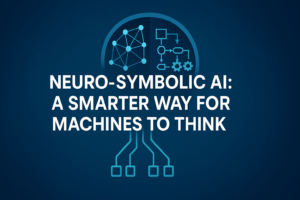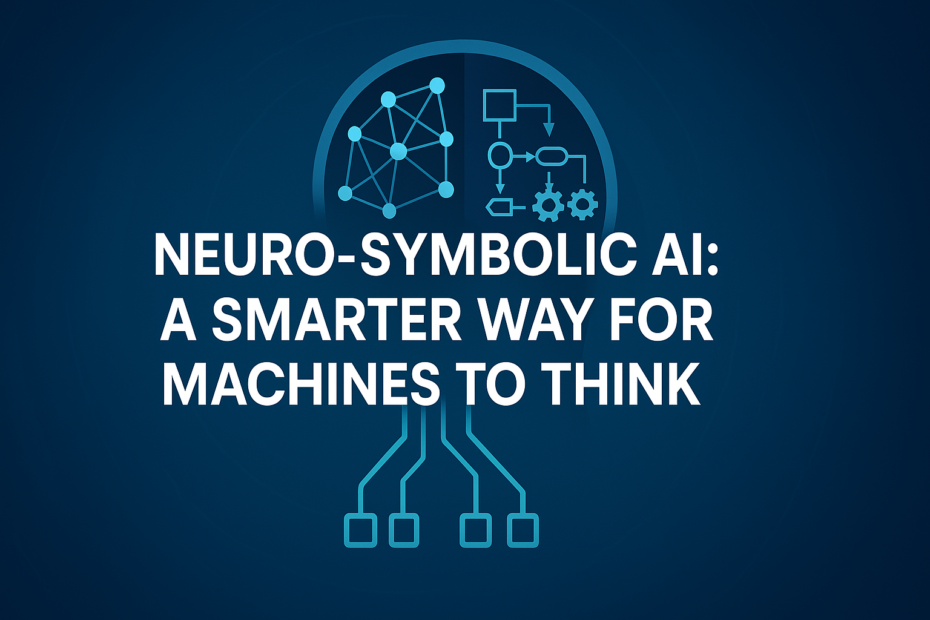
Let’s be honest—AI is getting pretty impressive these days. It can chat with us, write stories, drive cars, and even create art. But as smart as it seems, most AI still struggles with one big thing: understanding.
Sure, it can recognize patterns or answer questions, but ask it to explain its reasoning or follow logical steps, and it often falls apart. That’s where a newer idea called Neuro-Symbolic AI comes in.
This isn’t just another buzzword. It’s a clever way of combining two powerful but very different approaches to AI. And together, they could help machines reason more like humans do.
So, What Exactly Is Neuro-Symbolic AI?
It’s basically the fusion of two types of AI:
- Neural Networks – The “learning” side
These are good at spotting patterns in data—like recognizing faces, translating languages, or predicting the next word in a sentence. This is the tech behind tools like ChatGPT, Siri, and self-driving cars.
But neural networks are kind of like guessers. They learn from tons of examples, but they don’t really know why something is right or wrong.
- Symbolic AI – The “thinking” side
This is more about logic and rules. Think of it like following a checklist or using “if-then” statements. Symbolic AI is great at step-by-step reasoning.
But it’s not great with messy, real-world data. Show it a blurry picture or a noisy conversation, and it gets confused.
Neuro-Symbolic AI is a mix of both.
It’s an approach that lets AI see the world like a human (neural) and also reason through it like a human (symbolic).
A Real-Life Analogy
Think about how a child learns.
- They see lots of dogs, and over time they figure out what makes a dog a dog. That’s kind of like a neural network—learning from patterns.
- Then, they learn rules like “dogs bark” or “dogs are mammals.” That’s symbolic reasoning.
Neuro-Symbolic AI is trying to give machines this blend of instinct and logic. It’s what makes human intelligence so flexible—and machines could really use that.
Why Does This Matter?
Most AI today is either great at pattern recognition or at following rules—but not both. That’s a problem.
Here’s an example:
Let’s say you ask your AI assistant:
“If a cat is on the table, and the table gets knocked over, what happens to the cat?”
A neural network might get confused or guess randomly. A symbolic AI might understand the logic but fail to grasp the context.
But a Neuro-Symbolic AI could recognize the cat, understand the scene, and reason that the cat might fall or jump off to avoid danger. That’s deeper understanding.
Where Is This Being Used?
This is still a growing field, but it’s already showing up in some exciting areas:
Healthcare
- AI can scan medical images (neural) and apply medical guidelines (symbolic) to suggest treatments.
Education
- Smart tutors that adapt to each student’s way of learning—combining learning from examples and structured problem-solving.
Robotics
- Robots that not only see objects but understand how to interact with them, like stacking boxes or avoiding spills.
Legal and Business Tech
- AI that reads long documents, pulls out key information, and applies business or legal rules.
Cool Perks of Neuro-Symbolic AI
- ✅ More trustworthy: It can explain how it got its answer.
- ✅ Needs less data: It doesn’t always need millions of examples.
- ✅ More human-like: It reasons, not just guesses.
- ✅ Easier to debug: If it messes up, we can trace the logic.
So, What’s the Catch?
It’s not perfect yet. Building systems that blend learning and logic is tricky. Researchers are still figuring out how to make them work smoothly together.
Plus, this kind of AI often needs both good data and good rules, which can be hard to create or maintain.
Why It’s Worth Paying Attention To
AI is becoming a bigger part of our lives every day. But right now, a lot of it is still kind of a mystery box. It gives you an answer, but you don’t really know why or how.
Neuro-Symbolic AI brings us closer to AI that’s not just smart—but understandable, safe, and reliable.
Imagine:
- A medical AI that can walk a doctor through its reasoning.
- A virtual assistant that not only listens but thinks.
- A robot that learns on the job and reasons like a person.
That’s the kind of future Neuro-Symbolic AI is aiming for. And it’s not science fiction—it’s already starting to happen.
Final Thoughts
AI doesn’t need to be all guesswork or all logic. Like us, it can have both intuition and reason. That’s what Neuro-Symbolic AI is all about.
We’re still in the early days, but this approach could help create AI that really understands the world—not just reacts to it.
And that’s something worth getting excited about.
